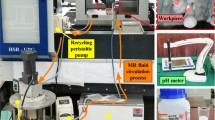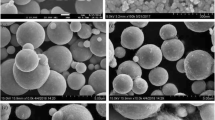Abstract
The existing material removal model of magnetorheological finishing cannot predict the material removal during part processing due to the problems of low processing efficiency, uniform removal, and difficulty in process control. In this paper, a new MRR (material removal rate) model is established to study the removal mechanism of fused silica glass based on the fluid mechanics and Preston’s equation, in which the influence of average load and magnetic interaction force is considered emphatically. To validate the validity of the MRR model, a suite of experiments is implemented on fused silica glass on separate process parameters, including the rotational speeds of workpieces, polishing time, machining gap, and X-direction deflection. A comparison is made between the experimental and model results, which are highly consistent. The results show that the expected load and magnetic interaction force are most responsive to the rotational speeds of the workpieces and machining gap, followed by the polishing time. At the same time, the X-direction deflection has marginal effects on the expected load and magnetic interaction force. Under irreversible experimental conditions of polishing time of 20 min, machining clearance of 2 mm, X-direction deflection of 10 mm, and workpiece rotation speed of 1000 rpm, the maximum MRR of the workpiece surface can be obtained as 0.497 μm/min.
















Similar content being viewed by others
Abbreviations
- MRR:
-
Material removal rate
- P l :
-
The normal load on individual particle in Preston’s equation
- P r :
-
Resultant pressure on workpiece in Preston’s equation
- P :
-
Polishing pressure of micro-grinding head acting on workpiece surface
- r 1 :
-
Distance from the center of magnetic pole to the boundary of polishing (buffing) disc
- P d :
-
Fluid dynamic pressure on workpiece surface
- P m :
-
Pressure exerted on the surface of a workpiece by a gradient magnetic field
- P M :
-
Force of interaction between magnetic grain
- N CIP :
-
Number of active carbonyl iron particle
- N Chain :
-
Number of active chain
- N M :
-
Number of active particle
- N :
-
Number of effective abrasive grain
- n p :
-
Number of pressing points
- V s :
-
Relative velocity between workpiece and polishing disc
- A p :
-
Area of polishing area
- A e :
-
The surface area of the workpiece
- E :
-
Young’s modulus
- P :
-
Polishing pressure
- k v :
-
Compressibility of MR fluids
- K :
-
Preston coefficient
- k c :
-
Fracture toughness of the workpiece
- H V :
-
Hardness of workpiece
- L m, c :
-
Average particle size of loaded grain
- Z :
-
Machining gap between the workpiece and the polishing disc
- △r/r :
-
The relationship between radial strains
- V :
-
Volume of cylindrical micro-grinding head
- V Z :
-
Total volume of abrasives in the polishing discs
- ε:
-
Radial stress
- \({\sigma}_{r_1}\) :
-
Stress of hardened magnetorheological fluid on workpiece
- B :
-
Magnetic flux density
- H :
-
Magnetic field strength of workpiece surface
- Φ:
-
Magnetic flux
- Φ0 :
-
Total magnetic flux on the magnetic pole surface
- Φa :
-
Axial magnetic flux of magnetorheological fluid
- f :
-
The radial magnetic flux density
- Z 1 :
-
Thickness of polishing film
- M :
-
Magnetization of carbonyl iron powder
- M f :
-
Magnetization of the entire magnetic field
- χm :
-
The polarization coefficient of the entire magnetic field
- β:
-
Magnetic susceptibility of carbonyl iron powder
- ω1 :
-
Rotational speeds of workpieces
- ω2 :
-
Rotational speeds of buffing disc
- e :
-
Rotation eccentricities of magnetic poles
- h e :
-
Film thickness function
- h 0 :
-
Film thickness at the maximum point of pressure
- ηN :
-
Newtonian fluid viscosity coefficient
- ηt :
-
Viscosity coefficient of pseudoplastic fluid
- η:
-
Working viscosity of the magnetorheological fluid
- ΦCIP :
-
Mass fraction of carbonyl iron powder in clustered magnetorheological finishing fluid
- ΦM :
-
Mass fraction of abrasive in clustered magnetorheological finishing fluid
- Φ:
-
Volume ratio of magnetic grain
- μ:
-
Magnetic permeability of carbonyl iron powder
- R 3 :
-
The distance between particles
- μ0 :
-
Permeability of vacuum
- μr :
-
Relative permeability of magnetic media
- μp :
-
Magnetic permeability of the carrier fluid
- μ1 :
-
Magnetic permeability of the magnetic particle
- R :
-
Distance from the center of the disc to the center of the magnetic pole
- R W :
-
Radius of workpiece
- r 1 :
-
Single polishing pad radius; polishing head radius
- ρC :
-
Density of carbonyl iron powder
- ρM :
-
Powder density of cerium oxide
- d CIP :
-
Particle size of carbonyl iron powder
- d M :
-
Abrasive particle size
References
Li Y, Zheng N, Li H, Hou J, Lei X, Chen X, Yuan Z, Guo Z, Wang J, Guo Y, Xu Q (2011) Morphology and distribution of subsurface damage in optical fused silica parts: bound-abrasive grinding. Appl Surf Sci 257(6):2066–2073. https://doi.org/10.1016/j.apsusc.2010.09.051
Wang H, Zhao K, Shen H, Yao Z (2020) Experimental study on direct fabrication of micro channel on fused silica by picosecond laser. J Manuf Process 55:87–95. https://doi.org/10.1016/j.jmapro.2020.03.057
Rasheed IA, Chhabra IM, Gupta MK, Karthikeyan B (2021) Surface preparation and analysis on fused silica glass substrate with deterministic grinding method. Mater Today 46:8239–8247. https://doi.org/10.1016/j.matpr.2021.03.221
Jiang C, Cheng J, Wu T (2017) Theoretical model of brittle material removal fraction related to surface roughness and subsurface damage depth of optical glass during precision grinding. Precis Eng 49:421–427. https://doi.org/10.1016/j.precisioneng.2017.04.004
Singh A, Garg H, Lall AK (2017) Optical polishing process: analysis and optimization using response surface methodology (RSM) for large diameter fused silica flat substrates. J Manuf Process 30:439–451. https://doi.org/10.1016/j.jmapro.2017.10.017
Gupta MK, Dinakar D, Chhabra IM, Jha S, Madireddy BS (2021) Experimental investigation and machine parameter optimization for nano finishing of fused silica using magnetorheological finishing process. Optik 226:165908. https://doi.org/10.1016/j.ijleo.2020.165908
Wang Z, Li H, Yu T, Chen H, Zhao J (2019) On the predictive modelling of machined surface topography in abrasive air jet polishing of quartz glass. Int J Mech Sci 152:1–18. https://doi.org/10.1016/j.ijmecsci.2018.12.041
Du M, Li Z, Dong X, Hao G, Du X, Che J, Zhang Y (2020) Experiment and simulation study of erosion mechanism in float glass due to rhomboid particle impacts. Int J Impact Eng 139:103513. https://doi.org/10.1016/j.ijimpeng.2020.103513
Hao G, Dong X, Du M, Li Z, Dou Z (2019) A comparative study of ductile and brittle materials due to single angular particle impact. Wear 428-429:258–271. https://doi.org/10.1016/j.wear.2019.03.016
Cao Z, Yan S, Li S, Zhang Y (2021) theoretical modeling and experimental analysis of single-particle erosion mechanism of optical glass. Micromachines 12(10):1221. https://doi.org/10.3390/mi12101221
Guo X, Yuan S, Huang J, Chen C, Kang R, Jin Z, Guo D (2020) Effects of pressure and slurry on removal mechanism during the chemical mechanical polishing of quartz glass using ReaxFF MD. Appl Surf Sci 505:144610. https://doi.org/10.1016/j.apsusc.2019.144610
Suratwala T, Menapace J, Steele R, Wong L, Tham G, Ray N, Bauman B, Gregory M, Hordin T (2021) Mechanisms influencing and prediction of tool influence function spots during hemispherical sub-aperture tool polishing on fused silica. Appl Optics 60:201–214. https://doi.org/10.1364/AO.410903
Luo X, Yang W, Qian Y (2021) Fixed abrasive polishing: the effect of particle size on the workpiece roughness and sub-surface damage. Int J Adv Manuf Technol 115:3021–3035. https://doi.org/10.1007/s00170-021-07363-1
Wang L, Zhou P, Yan Y, Guo D (2021) Investigation on nanoscale material removal process of BK7 and fused silica glass during chemical mechanical polishing. Int J Appl Glass Sci 12:198–207. https://doi.org/10.1111/ijag.15864
Pan J, Guo M, Yan Q, Zheng K, Xiao X (2019) Research on material removal model and processing parameters of cluster magnetorheological finishing with dynamic magnetic fields. Int J Adv Manuf Technol 100:2283–2297. https://doi.org/10.1007/s00170-018-2747-6
Ghosh G, Mandal P, Mondal SC (2019) Modeling and optimization of surface roughness in keyway milling using ANN, genetic algorithm, and particle swarm optimization. Int J Adv Manuf Technol 100:1223–1242. https://doi.org/10.1007/s00170-017-1417-4
Lu M, Zhuang X, Zhou J, Lin J, Li W (2022) A novel reciprocating cluster magnetorheological polishing device: design and investigation of removal model. Proc Inst Mech Eng Part B-J Eng Manuf. https://doi.org/10.1177/09544054221135484
Wang Y, Zhang Y, Feng Z (2016) Analyzing and improving surface texture by dual-rotation magnetorheological finishing. Appl Surf Sci 360:224–233. https://doi.org/10.1016/j.apsusc.2015.11.009
Jang D, Liu Y, Kim J (2015) Enhanced magnetorheology of soft magnetic carbonyl iron suspension with hard magnetic γ-Fe2O3 nanoparticle additive. Colloid Polym Sci 293:641–647. https://doi.org/10.1007/s00396-014-3475-6
Xu J, Li J, Cao J (2018) Effects of fumed silica weight fraction on rheological properties of magnetorheological polishing fluids. Colloid Polym Sci 296:1145–1156. https://doi.org/10.1007/s00396-018-4332-9
Luo B, Yan Q, Chai J, Song W, Pan J (2022) An ultra-smooth planarization method for controlling fluid behavior in magnetorheological finishing based on computational fluid dynamics. Precis Eng 74:358–368. https://doi.org/10.1016/j.precisioneng.2022.01.001
Alam Z, Jha S (2017) Modeling of surface roughness in ball end magnetorheological finishing (BEMRF) process. Wear 374-375:54–62. https://doi.org/10.1016/j.wear.2016.11.039
Liu J, Li X, Zhang Y, Tian D, Ye M, Wang C (2019) Predicting the material removal rate (MRR) in surface magnetorheological finishing (MRF) based on the synergistic effect of pressure and shear stress. Appl Surf Sci 504:144492. https://doi.org/10.1016/j.apsusc.2019.144492
Ranjan P, Balasubramaniam R, Suri VK (2014) Modelling and simulation of chemo-mechanical magnetorheological finishing (CMMRF) process. Int J Precis Technol 4:230–246. https://doi.org/10.1504/IJPTECH.2014.067743
Zhuang X, Lu M, Zhou J, Lin J, Li W (2022) Improved magnetorheological finishing process with arc magnet for borosilicate glass. Mater Manuf Process 37:458–466. https://doi.org/10.1080/10426914.2021.2006222
Funding
This work was supported by the Jilin Province Science and Technology Development Key Project (20200401109GX), Jilin Province Micro-Nano and Ultra-Precision Manufacturing Key Laboratory (20140622008JC), Changchun Science and Technology Development Plan Project (21zgg08).
Author information
Authors and Affiliations
Contributions
Weixing Li: investigation, methodology, validation, writing—original draft, writing—review and editing; Limin Zhang: methodology, validation, experiments, writing—original draft, writing—review and editing; Mingming Lu: writing—review and editing; Jinqiong Lin: writing—review and editing; Yuyang Liu: software, data curation; Changqing Liu: software, data curation.
Corresponding author
Ethics declarations
Conflict of interest
The authors declare no competing.
Additional information
Publisher’s note
Springer Nature remains neutral with regard to jurisdictional claims in published maps and institutional affiliations.
Rights and permissions
Springer Nature or its licensor (e.g. a society or other partner) holds exclusive rights to this article under a publishing agreement with the author(s) or other rightsholder(s); author self-archiving of the accepted manuscript version of this article is solely governed by the terms of such publishing agreement and applicable law.
About this article
Cite this article
Zhang, L., Li, W., Lu, M. et al. Material removal mechanism of fused silica glass in magnetorheological finishing. Int J Adv Manuf Technol 128, 1271–1289 (2023). https://doi.org/10.1007/s00170-023-11970-5
Received:
Accepted:
Published:
Issue Date:
DOI: https://doi.org/10.1007/s00170-023-11970-5




